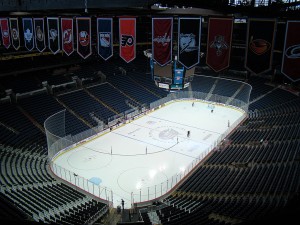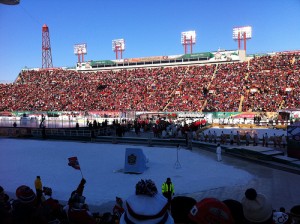
The 2004-05 National Hockey League lockout had a few significant effects. While the work stoppage had the positive effect of providing new-found parity between all 30 NHL teams on the ice, it could not do the same thing off of it. Attendance in some markets has continued to be wildly erratic. Presented here are three comparative measurements attempting to find the NHL’s attendance trouble spots.
Games With Fewer Than 10,000 Fans
Since the lockout, there have been 92 games played with fewer than 10,000 fans in attendance. The breakdown is as follows: 31 on Long Island, 24 in Phoenix, 11 in St. Louis, six in Columbus, five each in New Jersey and Chicago, four in Atlanta, three in Dallas and one each in Stockholm, Carolina and Buffalo.
Long Island and Phoenix are addressed in detail later on. St. Louis’ empty-arena games were concentrated in the disastrous 2006/07 season, with the Blues’ dead-last finish from the prior season resulting in a 12,150 average attendance. Chicago’s first three post-lockout seasons saw the team gradually rebuild, so the low numbers were a product of a sub-par team. Similarly, Carolina and Buffalo’s entries were during the worst attendance years they had during the post-lockout period (and Buffalo’s “home” game was played in Rochester‘s small BlueCross Arena – thanks to Jay in the comments for the heads up). Stockholm was simply a small venue during the NHL’s Premiere series in Europe.
New Jersey attendance generally suffers due to fan reliance on transit and as a result, most of their really low attendance games are a result of nasty weather gumming up the works. Dallas’ attendance has suffered in recent years, as has the team’s on-ice performance, but the three sub-10,000 fan games occurred early in the 2011-12 season during the Texas Rangers’ march to the World Series.
Long Island, Phoenix, Columbus and Atlanta are a different story.
Lowest Average Attendance
Generally speaking, small crowds are a product of a weak market. The bottom five teams in attendance since the lockout are the New York Islanders (12,784), Phoenix (14,074), Atlanta (14,887), New Jersey (15,012) and Nashville (15,121).
During this period, the Islanders made the playoffs just once and were 20 points out of the playoffs twice. Phoenix has made the playoffs over the past two seasons, but the only effect that has had was to even out the attendance free-fall (stabilizing things at roughly 12,000 fans). Atlanta missed the playoffs all but one year, and that year was the Thrashers’ best for attendance. The Devils made the playoffs every season except for 2010-11, but their attendance consistently was stuck at the 15,000 mark. Similarly, Nashville was remarkably consistent during the sample period – making the playoffs all but one season and having consistent 15,000 attendance.

Not surprisingly, several venues saw no real change in attendance, despite their teams having disappointing numbers. Again, not surprisingly, many of those venues are in Canada or “traditional” hockey markets: Montreal, Detroit, Philadelphia, Pittsburgh, Toronto, Calgary, Edmonton, Ottawa, Vancouver, Minnesota and New York. Some of the less-traditional markets have shown remarkable consistency: San Jose, Los Angeles, Anaheim, Tampa Bay and Florida have all been strong, even when the teams were less than stellar.
Lowest Average Utilized Capacity
While attendance figures can be quite frightening, the recent addition of Winnipeg’s MTS Centre to the NHL has brought up a very good point: Attendance numbers don’t really matter as long as the arena is full.
Again, there are a handful of usual suspects in the lower ranges: Long Island (79%), Atlanta (81%), Phoenix (82%) and New Jersey (83%). Columbus (85%) is also a weak sister.
On the flip side, there are eight venues that have been at (or above) 100% capacity throughout the last seven seasons. None of the names are really all that surprising: Montreal, Philadelphia, Toronto, Calgary, Vancouver, Minnesota, New York and Edmonton. The next group (running at 98-99%) includes Detroit, Ottawa, Buffalo, Pittsburgh and San Jose.
Considering this, it isn’t that shocking that of the seven NHL games held in outdoor stadiums, five have been held in markets that consistently sold out games (regardless of on-ice performance) while the other two were in resurgent markets with strong teams (Boston and Chicago).
Conclusions
Generally speaking, if your team is strong, you will sell out games. If your team is lousy, you will still sell out games if your team is in Canada or Detroit, Pennsylvania, Manhattan, Buffalo, California or Minnesota.
On the other hand, the Thrashers’ move to Winnipeg solved one of the NHL’s attendance problem spots, but not the worst one. Phoenix and Long Island are easily just as bad for attendance as Atlanta used to be, and there is seemingly no end in sight. Worse, despite being a pretty competitive young team, Columbus’ attendance figures are gradually eroding.
Unfortunately, there are no easy solutions. The strongest markets in the AHL or ECHL are already well-served by existing NHL teams, so there aren’t any venues that scream for an NHL club. For now, the only way for Phoenix and the Islanders to become viable franchises again may be to radically improve the on-ice product.
Fantastic article. Just to add a little bit of perspective on the Blues’ situation. The first two seasons after the lockout were unmitigated disasters. It was the first time the team had missed the playoffs in a generation, the ownership group cried poor and shipped off Pronger and alienated a loyal fan base.
New ownership got the attendance figures moving in the right direction, and a non-playoff team sold out every game last year. The two post lockout years are more the exception than the rule.
I think it is worth mentioning that average ticket price has a strong effect on attendance. For instance, I believe that the Devils have the highest avg ticket prices in the NHL (or nearly so). So while attendance numbers matter, this doesn’t tell the whole story, especially when money/revenues are the real heart of the matter. Where the real problems lie is where attendance AND ticket prices are low.
Hi, Aaron. Thanks for the comment. I’m working on a follow-up in the near future looking at average gate revenues and the cap floor. An acquaintance of mine from the Los Angeles area is fairly convinced that the NHL’s cap floor may be a bad thing, as it locks many teams into spending perilously close to their maximum revenue generating point.
To add with some.
If the Islanders played in the city instead of Nassau County, would they sell out every time? Probably not, considering how horrid their team has been, but it would be far better off. Who would want to drive from, or through NYC to catch an Isles game, especially one featuring a bad team?
Same with the Devils. For the longest time, they played in the Meadowlands. For football (like the Jets and Giants), you can get away with playing there, since thats a once a week, for the nation’s favorite sport. For hockey (and even Basketball), playing where the Devils played was a BAD idea. They had the right idea moving their arena to right off a mass-transit line in Newark.
Columbus, Phoenix, Atlanta… those just show if you go to a market, and produce crap, the fans will respond in kind, and not give a crap about a sport they had little intrest in. See San Jose. See Dallas before ownership went bad. See Tampa Bay. Those teams came to non-traditional markets (in San Jose’s case, a market that had been quite poisioned nearly 20 years prior, thanks to the Golden Seals), committed to building winners, and it has (or had) rewarded them well. Hell, imagine Nashville if their ownership wasn’t committed to trying to put out a winner. They probably would have left town already.
Thank you. Best article of the season so far: factual, informative, evenhanded. Props.
One idea which should be given more serious thought would be to remove a couple rows in the front and make the rink bigger. This would increase the attendance/capacity ratio by cutting out a few seats, and result in a better overall product (so many reasons here….), which would then increase attendance and demand for tickets. Short sighted owners and lack of commissioner leadership will keep us waiting at least another 10-15 years….
“Similarly, Carolina and Buffalo’s entries were during the worst attendance years they had during the post-lockout period”.
Using Buffalo in the above quote is not a good example. That Buffalo game (versus the Capitals) where the attendance was 8,552 was played in Rochester, NY at Blue Cross Arena…. NOT in Buffalo.
oh oh oh…and the Carolina game was one during a snowstorm….and yeah, stop rolling your eyes, we do only get one of those a year….
Penguions Avg Attendance during “Bad Team Years”:
http://espn.go.com/nhl/attendance
2000-2001: 16,277 for 16th in the league
2001-2002: 15,649 for 22nd in the league
2002-2003: 14,750 for 25th in the league
2003-2004: 11,877 for 30th in the league
Even precious markets like Pittsburgh that everyone thinks “deserves” to be around go through attendance slumps with poor on ice performance. Imagined if no arena deal was struck and they were moved before the arrival of a great team in Sid and company.
This article is rediculous. How can you give an excuse for Chicago and St. Louis for attendance woes because of “sub par” performance but then bash Columbus as a market because it has a “pretty competitive young team”? Our team has been competitive only once in 11 years.
This article is only good for one thing, and that is the stat on how many games have been played in front of fewer than 10,00 fans in the NHL. All the added personal opinions are ignorant and obviously lack knowledge or research.